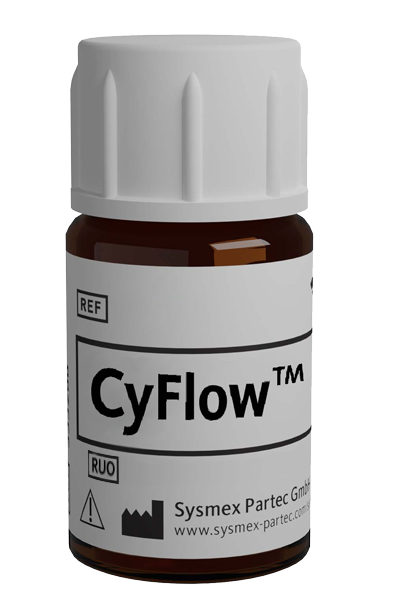CyFlow™ CD90 FITC

| Alternative Name: | THY-1 |
| Antibody: | Yes |
| Antigen: | CD90 |
| Application: | Flow cytometry |
| Clonality: | monoclonal |
| Clone: | 5E10 |
| Emission Maximum: | 518 nm |
| Excitation Maximum: | 490 to 495 nm |
| Field of Interest: | Immunophenotyping |
| Format/Fluorochrome: | FITC |
| Isotype: | IgG1 |
| Laser: | Blue |
| Regulatory Status: | RUO |
| Source Species: | Mouse |
| Target Species: | Horse, Human, Non-Human Primates, Pig |
| Product number: | CM289877 |
For Research Use Only
| Quantity | 100 tests |
| Volume | 0.4 mL |
| Immunogen | HEL erythroleukemia cells |
| Background Information | CD90 (Thy-1) is an 18-35 kDa GPI-anchored plasma membrane glycoprotein expressed in many cell types, such as in hematopoietic cells and neurons, connective tissues, various fibroblast and stromal cell lines, tumor endothelial cell lines and other. It is involved in T cell activation, cellular adhesion, proliferation and migration, neurite outgrowth, wound healing, apoptosis, and fibrosis. CD90 participates in multiple signaling cascades and its effects are tissue- and cell type-specific. It often functions as an important regulator of cell-cell and cell-matrix interactions. |
| Usage | The reagent is designed for Flow Cytometry analysis of human blood cells. Recommended usage is 4·µl reagent·/ 100·µl of whole blood or 10^6 cells in a suspension. The content of a vial (0.4 ml) is sufficient for 100 tests. |
| Storage Buffer | The reagent is provided in stabilizing phosphate buffered saline (PBS) solution, pH ≈7.4, containing 0.09% (w/v) sodium azide. |
| Storage | Avoid prolonged exposure to light. Store in the dark at 2-8°C. Do not freeze. |
| Stability | Do not use after expiration date stamped on vial label. |
| St Louis DC, Woodcock JB, Franzoso G, Blair PJ, Carlson LM, Murillo M, Wells MR, Williams AJ, Smoot DS, Kaushal S, Grimes JL, Harlan DM, Chute JP, June CH, Siebenlist U, Lee KP: Evidence for distinct intracellular signaling pathways in CD34+ progenitor to dendritic cell differentiationfrom a human cell line model. J Immunol. 1999 Mar 15; 162(6):3237‑48. < PMID: 10092775 > | Ito T, Inaba M, Inaba K, Toki J, Sogo S, Iguchi T, Adachi Y, Yamaguchi K, Amakawa R, Valladeau J, Saeland S, Fukuhara S, Ikehara S: A CD1a+/CD11c+ subset of human blood dendritic cells is a direct precursor of Langerhans cells. J Immunol. 1999 Aug 1; 163(3):1409‑19. < PMID: 10415041 > | Seiffert M, Brossart P, Cant C, Cella M, Colonna M, Brugger W, Kanz L, Ullrich A, Bühring HJ: Signal‑regulatory protein alpha (SIRPalpha) but not SIRPbeta is involved in T‑cell activation, binds to CD47 with high affinity, and is expressed on immature CD34(+)CD38(‑) hematopoietic cells. Blood. 2001 May 1; 97(9):2741‑9. < PMID: 11313266 > | Chin-Yee IH, Keeney M, Stewart AK, Belch A, Bence-Buckler I, Couban S, Howson-Jan K, Rubinger M, Stewart D, Sutherland R, Paragamian V, Bhatia M, Foley R: Optimising parameters for peripheral blood leukapheresis after r‑metHuG‑CSF (filgrastim) and r‑metHuSCF (ancestim) in patients withmultiple myeloma: a temporal analysis of CD34(+) absolute counts and subsets. Bone Marrow Transplant. 2002 Dec; 30(12):851‑60. < PMID: 12476276 > | Carlsten M, Björkström NK, Norell H, Bryceson Y, van Hall T, Baumann BC, Hanson M, Schedvins K, Kiessling R, Ljunggren HG, Malmberg KJ: DNAX accessory molecule‑1 mediated recognition of freshly isolated ovarian carcinoma by resting natural killer cells. Cancer Res. 2007 Feb 1; 67(3):1317‑25. < PMID: 17283169 > | Kroeze KL, Jurgens WJ, Doulabi BZ, van Milligen FJ, Scheper RJ, Gibbs S: Chemokine‑mediated migration of skin‑derived stem cells: predominant role for CCL5/RANTES. J Invest Dermatol. 2009 Jun; 129(6):1569‑81. < PMID: 19122644 > | Hoppstädter J, Diesel B, Zarbock R, Breinig T, Monz D, Koch M, Meyerhans A, Gortner L, Lehr CM, Huwer H, Kiemer AK: Differential cell reaction upon Toll‑like receptor 4 and 9 activation in human alveolar and lung interstitial macrophages. Respir Res. 2010 Sep 15; 11:124. < PMID: 20843333 >
